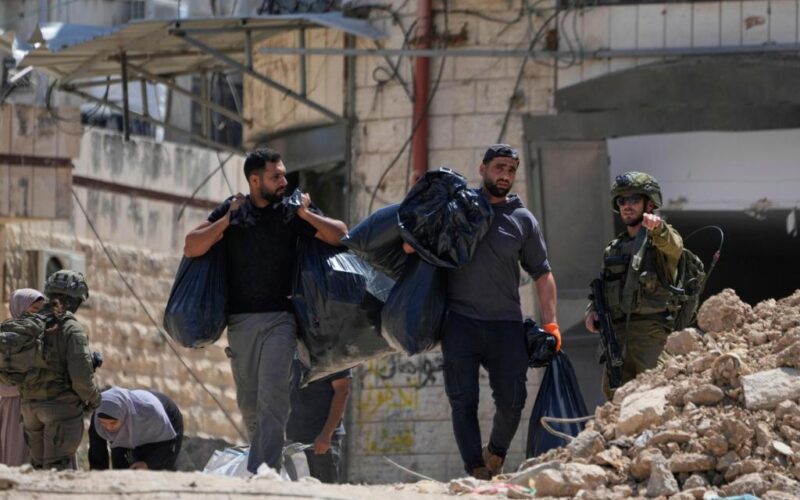By JULIA FRANKEL and NATALIE MELZER
JERUSALEM (AP) — Israel said Thursday it would establish 22 more Jewish settlements in the occupied West Bank, including the legalization of outposts already built without government authorization. In the Gaza Strip, Israeli strikes killed at least 34 people, local health officials said.
Israel captured the West Bank, along with Gaza and east Jerusalem, in the 1967 Mideast war and the Palestinians want all three territories for their future state. Most of the international community views settlements as illegal and an obstacle to resolving the decades-old conflict.
Defense Minister Israel Katz said the settlement decision “strengthens our hold on Judea and Samaria,” using the biblical term for the West Bank. He said it “anchors our historical right in the Land of Israel, and constitutes a crushing response to Palestinian terrorism.”
He added that the construction of settlements was also “a strategic move that prevents the establishment of a Palestinian state that would endanger Israel.”
Watchdog group says it’s the biggest expansion since Oslo
The Israeli anti-settlement watchdog Peace Now said the announcement was the most extensive move of its kind since the 1993 Oslo accords that launched the now-defunct peace process. It said the settlements, which are deep inside the territory, would “dramatically reshape the West Bank and entrench the occupation even further.”
Israel has already built well over 100 settlements across the territory that are home to some 500,000 settlers. The settlements range from small hilltop outposts to fully developed communities with apartment blocks, shopping malls, factories and parks.
The West Bank is home to 3 million Palestinians, who live under Israeli military rule with the Palestinian Authority administering population centers. The settlers have Israeli citizenship.
Peace Now said the plans call for the authorization of 12 existing outposts, the development of nine new settlements and reclassifying a neighborhood of an existing settlement as a separate one.
“The government is making clear — again and without restraint — that it prefers deepening the occupation and advancing de facto annexation over pursuing peace,” the group said.
Settlements expand with little or no U.S. pushback
Israel has accelerated settlement construction in recent years — long before Hamas’ Oct. 7, 2023, attack ignited the war in Gaza — confining Palestinians to smaller and smaller areas of the West Bank and making the prospect of establishing a viable, independent state even more remote. Hamas has been designated as a terrorist organization by the United States, Canada and the European Union.
During his first term, President Donald Trump’s administration broke with decades of U.S. foreign policy by supporting Israel’s claims to territory seized by force and taking steps to legitimize the settlements. Former President Joe Biden, like most of his predecessors, opposed the settlements but applied little pressure to Israel to curb their growth.
The top United Nations court ruled last year that Israel’s presence in the occupied Palestinian territories is unlawful and called on it to end, and for settlement construction to stop immediately.
Israel denounced the non-binding opinion by a 15-judge panel of the International Court of Justice, saying the territories are part of the historic homeland of the Jewish people.
Calls for settlements in war-ravaged Gaza
Israel withdrew its settlements from the Gaza Strip in 2005, but leading figures in the current government have called for them to be re-established and for much of the Palestinian population of the territory to be resettled elsewhere through what they describe as voluntary emigration.
Palestinians view such plans as a blueprint for their forcible expulsion from their homeland, and experts say the plans would likely violate international law.
Israel now controls more than 70% of Gaza, according to Yaakov Garb, a professor of environmental studies at Ben Gurion University, who has examined Israeli-Palestinian land use patterns for decades.
The area includes buffer zones along the border with Israel as well as the southern city of Rafah, which is now mostly uninhabited, and other large areas that Israel has ordered to be evacuated.
Strikes kill at least 34 in Gaza
An Israeli airstrike hit a house sheltering several families in Bureij, an urban refugee camp in central Gaza, killing 22 people, including nine women and children, according to officials at nearby Al-Aqsa Martyrs Hospital. An AP journalist viewed the hospital records of the dead.
Strikes in northern Gaza late Wednesday and early Thursday hit a house, killing eight people, including two women and three children, and a car in Gaza City, killing four, local hospitals said.
There was no immediate comment from the Israeli military, which says it only targets combatants and blames civilian deaths on Hamas because the fighters operate in populated areas.
Israel’s campaign in Gaza aimed at destroying Hamas has killed over 54,000 Palestinians, mostly women and children, according to Gaza’s Health Ministry, whose count does not distinguish between civilians and combatants.
The campaign was triggered by Hamas’ Oct. 7 attack, in which terrorists stormed into Israel, killing some 1,200 people, mostly civilians, and abducting 251. Hamas still holds 58 hostages, around a third of them alive, after most of the rest were released in ceasefire agreements. Israeli forces have rescued eight and recovered dozens of bodies.
Melzer reported from Nahariya, Israel. Associated Press writers Kareem Chehayeb in Beirut and Sam Mednick in Tel Aviv, Israel, contributed to this report.
Originally Published:













